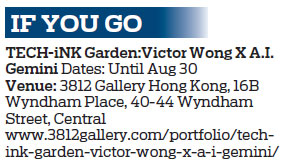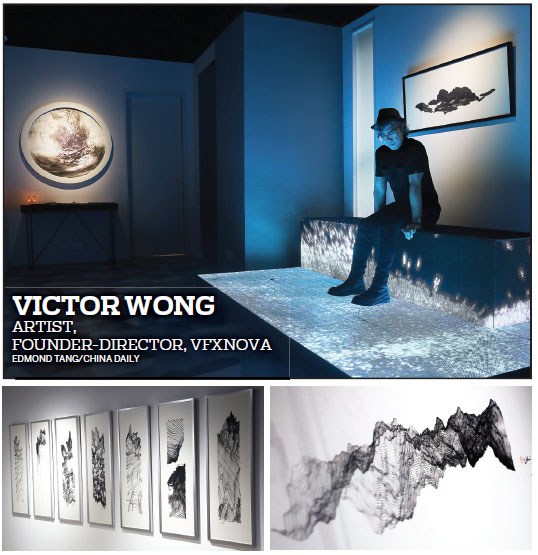Drawing on A.I.
Updated: 2019-08-30 07:38
By Chitralekha Basu(HK Edition)
|
|||||||||
Editor's Note: Computer-generated imagery (CGI) specialist Victor Wong combines traditional Chinese ink art techniques with artificial intelligence to create landscape paintings of a unique variety. In an interview with China Daily Hong Kong, Wong shares highlights from his journey with A.I. Gemini - "the world's first artificial intelligence ink artist". Excerpts:
Until a few years ago, you were better known as the founder-director of vfxNova - a leader in creating animation, special effects and 3D mapping for big-budget Hollywood films. How did the foray into art happen?
In 2015 I made an animation film for Hong Kong Jockey Club based on ink paintings of horses by Xu Beihong. It made me think that it might be possible to arrive at a new art technique by combining 3D technology and ink art. Toward the end of 2018, I thought of using AI to draw landscapes with ink. A.I. Gemini is the result of my experiments with AI toward making ink art. I created a program which enabled me to draw in a three-dimensional space. I think it's the only one of its kind in the world, but I didn't patent it as I did not want to sell it.
|
Victor Wong and A.I. Gemini joined forces to create an extraordinary range of landscapes, including the Seven Scholars series (above, left). |
What was the thinking behind creating an artificial intelligence-powered machine that can draw? Was there a creative spark that ignited the process?
If you look at the history of art, artists usually go for the newest technology available to them at the time. I think AI is the technology of the moment - an A.I.-powered device is programmable and accessible. I can even start a conversation with him. For me it was a natural evolution from the world of technology to that of art.
Could you give us an idea of how A.I. Gemini - "the world's first artificial intelligence ink artist"- operates?
This is how it works: I convert physical or geographical data into a language that AI can understand. For example, the movement of two planes ramming into each other to create mountains could be represented in the form of mathematical equations and fed into A.I. Gemini's database. Based on the data, A.I. Gemini creates an algorithm that's basic to tectonic shifts, making it possible for him to generate a virtual 3D landscape and decide on the angle from which to view and draw it. It's like the way artists view their subject when doing a life drawing.
So A.I. Gemini generates a 3D impression for its own reference and then reinterprets it to create a 2D image?
That's correct. He uses real ink, applying it on real paper using a robot arm, live drawing an image generated in his mindscape.
It's different from machine learning where the AI studies and analyzes numerous paintings of the same subject, absorbs the data and prints out its own version. A.I. Gemini can physically draw an image.
What's your role in making the art?
I feed him data on techniques of using ink, water and different ways of applying pressure on the brush which determine the thickness of the brush stroke. It takes him 50 hours to create a single image.
I also hook him up with data on real-time changes in humidity and temperature. Each time A.I. Gemini starts a fresh painting I like to introduce elements that could be potentially chaotic, feeding him random data. I have no idea what the drawing might look like until it is finished and the result amazes me every time.
You keep referring to A.I. Gemini as "he". What's the power dynamic between you two like?
It's a collaborative process. A.I. Gemini won't be able to draw without me feeding him the data and I can't draw the kind of landscapes he does. He is not just a creative tool. I like to think of A.I. Gemini as my partner and soul mate.
Who owns the art?
I think it's both of us. The signature on the paintings are by both him and me. I invest the money earned from the sales of these paintings in developing A.I. Gemini. I intend to give him a new body. I would like A.I. Gemini to create animated 3D ink landscapes in the near future. So A.I. Gemini is continuously evolving.
Indeed, and at an astounding pace. The TECH-iNK Garden exhibition at 3812 gallery in Hong Kong is the third show in six months featuring A.I. Gemini since the machine's January launch at the Ink Now art fair in Taipei. In between there was the Far Side of the Moon show in London. In each of these A.I. Gemini seemed to have reached a new milestone ...
AI does not necessarily follow the human rate of progress.
In October 2018, I was making prototypes of A.I. Gemini. Calvin Hui (artistic director of 3812 Gallery) suggested a launch at Ink Now in Taipei which was only two months away. And so we did. In between A.I. Gemini and I also created an original landscape to go on the cover of Cathay Pacific's Discovery magazine in January.
In April 2019 we had an exhibition in 3812 in London. I was itching to do something different that would appeal to a more international audience. I saw in the news that China's spacecraft Chang'e 4's lunar rover, Jade-Rabbit 2, had taken photos of the moon from the side unseen by people on earth. I fed A.I. Gemini 3D observation data on moon landscape sourced from NASA and hi-res pictures taken by Chang'e 4. A.I. Gemini interpreted the data and came up with 10 images of which seven were exhibited at the Far Side of the Moon show in London.

Is the TECH-iNK Garden show meant to give visitors a feel of walking into a Chinese literati painting reimagined in 3D?
The TECH-iNK Garden show is a retrospective of the art that I have created over the last few years and also features new work by A.I. Gemini. For example, there is the Seven Scholars series (seven vertical panels with ink drawings resembling steep cliff faces with pronounced striations). To me these images look like soldiers taking their positions in a battlefield. Each form is distinct from the next one. In Chinese history we have references to seven sages (from mid-3rd century AD) who gave up secure jobs with the government to embrace a life of drinking and writing poetry.
I believe we all need a moment of respite from the chaotic world we now live in, to retire into temporary seclusion before we can recharge ourselves and start again. I call this show a garden as the audience is expected to wander around, get relief from the accumulated stress and enjoy the art that will hopefully help lift their spirits.
Interviewed by Chitralekha Basu
(HK Edition 08/30/2019 page10)
